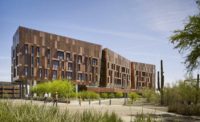Modern architecture has evolved rapidly over the past decade thanks to the use of more sustainable building materials, environmentally conscious standards and the paramount importance placed on aesthetics. Designing today isn’t just about structural integrity, it’s about the building’s impact on the environment, and what type of visual style it can introduce or master. As this expressive architectural trend continues to flourish, it’s had a monumental impact on wall cladding creativity and material choice, especially copper and copper alloys.
Wall cladding is the skin of a building, the first layer of architectural expression and thought. To reach their goals, more and more firms are turning to copper. Over the past 10 years, copper wall cladding has exploded onto the scene in top-tier and highly visible projects across North America, such as the American Copper Buildings in Manhattan. In the world of architecture where material competition is fierce, what’s copper’s secret?
Copper: Man’s First Metal
First discovered almost 9,000 years ago, copper has been used by humans since ancient civilization and is still used today. The metal has played an integral role in the advancement of human society. Today, copper transports clean water through piping, governs our electrical grid through wiring, and mesmerizes our society through architecture.
From the roofing shingles installed atop the Lowa Maha Paya Temple in Sri Lanka during the third century B.C.E., to the 160,000 pounds used to form the Statue of Liberty, copper is one of architecture’s oldest and most prestigious materials. Thanks to modern architecture’s recent evolutions, copper wall cladding has grown dramatically due to its applicability to sustainable building standards, its versatility, and its overall aesthetic appeal.
Why the Red Metal is Actually Pretty Green
Society’s environmental consciousness has spurred an observable—and rapid—growth in copper wall cladding installations and systems over the past 10 years. As sustainability becomes a more prominent focus in modern building projects, building owners, specifiers, contractors and architects are realizing the importance of sustainable building practices.
There are several modern standards that reward sustainable building practices and environmental ethics, such as Leadership in Energy and Environmental Design (LEED) and the International WELL Building Standard (WELL). While there are many building materials that may be used in different areas of these standards, few are as widely applicable as the red metal.
Architectural copper and copper alloys (brass, bronze, nickeled silver, etc.) can be used in 224 different instances to help achieve certification in these programs, including 82 instances for LEED and 12 for WELL. This makes copper a very attractive material for environmental conscious decision-makers, which in turn helps elevate its use for wall cladding projects. But, how exactly is the metal so widely applicable to sustainability standards? This is predominantly from two of its attributes: durability and recyclability.
- Durability—Architectural copper applications can easily last 100+ years without sacrificing performance. This extreme longevity means new materials aren’t needed for frequent replacements or repairs, thus reducing the strain placed on our environment. Since copper is a naturally occurring metal, it doesn’t require any protective coatings or added maintenance. Once installed, it can be left alone to age naturally for nearly a century.
- Recyclability—Copper is infinitely recyclable and its overall recycling rate is higher than any other engineering metal, helping us construct more sustainably and reduce the consumption of new materials. The modern system of recycling copper is so efficient, nearly half the supply in the United States comes from recycling.
When only considering the sectors of the copper industry critical to architecture, such as brass mills, ingot makers, foundries, powder plants and others, 72 percent of the copper comes from recycled “scrap” like wiring, chips or even other architectural applications. The Canadian War Museum for example, a 2008 North American Copper in Architecture (NACIA) Award Winner, used copper recycled from the Ottawa Parliament roof. This can also provide affordability, as recycled copper maintain 95 percent of its original value; older parts can simply re-enter the supply and be forged into new products.
Due to these highly attractive characteristics, copper can be applied to a wide variety of sustainable building practices, which has contributed to its increasingly rapid use for wall cladding applications. This can been seen through one of the 2018 NACIA Award Winners, the Shane Homes YMCA in Calgary, Alberta. To help achieve LEED Gold certification, the designers of this 248,000-square-foot multi-use facility utilized a stunning brass shingle system that naturally blends into Alberta’s rolling prairies and foothills. Judging by the YMCA’s environmental certifications and its stunning beauty, it’s no wonder copper wall cladding is on the rise.
Bend, but Don’t Break
As complex designs become more commonplace, wall cladding systems are becoming more intricate and often require a great deal of bending and forming. Copper is a highly malleable metal that allows dozens of different methods of formation, many of which are specified in the Copper in Architecture – Design Handbook, a free online resource provided by the Copper Development Association (CDA). The combination between increasing architectural creativity and its ability to meet the demands of complex structures has contributed to the rise of copper wall cladding.
The Biomedical Sciences Partnership Building at the University of Arizona’s Phoenix Campus, a 2017 NACIA Award Winner, used over 295,000 pounds of copper to create a stunning wall cladding system through 4,800 formed, bent and perforated panels. The design team needed a malleable and ductile material that could be fabricated without breaking—they chose architectural copper. The building’s cladding is comprised of 26 different panel patterns that were shaped, bent and folded into place to create a “sunscreen,” or an intricate design that reflects light away from the building. This reduces the exterior and interior temperature of the building, helping slash the building’s energy costs by 16 percent. Not to mention, the biomedical facility’s cladding is made of 90-95 percent recycled copper and is LEED Silver-certified.
Beauty Beyond Bounds
The third major reason for the rise of copper wall cladding is its pure, honest beauty. When it was announced in 2008 that the Domino Sugar Factory campus, a defunct industrial zone alongside Brooklyn’s East River waterfront, would be redeveloped into a residential and commercial area, the proposed design was “universally hated” because its “…Hulking buildings were bland and boxy.” There is a demand—from both the professional community and the general public—that modern architecture present contemporary and aesthetic design. In 2013, when a local firm stepped in with a new design, they unsurprisingly presented an extensive use of architectural copper.
A major aesthetic factor that is increasing copper’s wall cladding appeal is its blue-green patina. As the metal ages, it naturally changes colors, allowing the material to match a variety of styles and appearances that “evolve” with the building. Copper’s patina is formed by oxidation; as the metal chemically reacts to the elements, a natural—and harmless—oxide layer forms, gently changing its color over the years. While this layer actually helps protect the copper from corrosive or otherwise harmful pollutants, it also creates a natural, progressive beauty that is difficult for other materials to match.
A 2016 NACIA Award Winner, the Eagle Harbor Market Building from Bainbridge Island, Wash.; and a 2018 NACIA Award Winner, the Holbrook PreK-12 School from Holbrook, Mass. are both gorgeous examples of copper’s patina and how it charms a building’s exterior.
When it comes to a patina, there are timeline options, too. An architect can allow the patina to naturally form over the years, use safe weathering techniques to quickly apply the patina, or use “pre-patina” components. For the Eagle Harbor Market, a local architectural metals company was enlisted to quickly apply the patina to the project’s copper; for the Holbrook PreK-12 School, the contracting team used copper panels that had already formed a patina. These patina options provide added flexibility when considering different applications, as well as the guaranteed beauty of a copper wall cladding system.
Blazing a Trail
As architecture grows more diverse, creative and sustainable, copper wall cladding has rapidly become a popular application and style. If you or your colleagues have questions, we encourage you to reach out. CDA has a dedicated team of architecture and copper experts who collectively field over 1,500 calls every year on copper projects across North America.
If you’ve completed a copper architecture project within the past three years, the 2019 NACIA Awards are right around the corner! Whether it’s a residence, religious structure, educational facility, government related or even a small garage, we want to see how you’ve used copper to improve a building. Check out copper.org for updated or to submit your projects!









